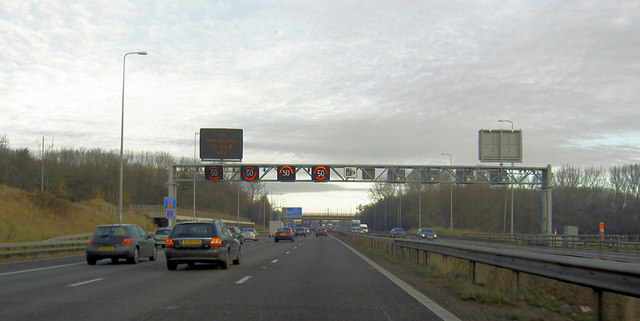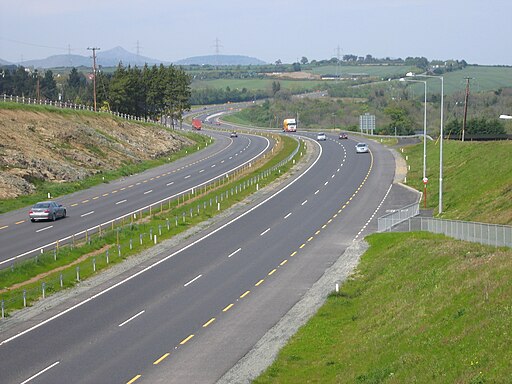The hard shoulder, which is also known as the “emergency lane”, is an essential safety feature on UK motorways, providing a space for vehicles to pull over in case of an emergency. Knowing when and how to use the hard shoulder can make a crucial difference in ensuring your safety on the road.
Driving on motorways in the UK can be a convenient and efficient way to get to your destination. However, emergencies can happen at any time, and it’s crucial to understand the importance of the hard shoulder.
Whether you’re a new driver or an experienced one, it’s essential to know when and how to use the hard shoulder, as well as the safety measures you need to take in case of an emergency.
In this article, we’ll guide you through everything you need to know about hard shoulders on UK motorways and how to stay safe while using them.
What is the hard shoulder?
A hard shoulder is the area of a motorway or dual carriageway that runs alongside the main carriageway and is used for emergencies, breakdowns, and as a refuge for vehicles that need to stop. It is usually marked with a solid white line and is located on the left-hand side of the carriageway.
The ‘shoulder’ of a road is the land to the edge of the road. On most roads without pavements, the shoulder is a strip of grass or a hedgerow. This is known as a ‘soft shoulder’.
Where are hard shoulders?
Hard shoulders are located on the far left of motorways and dual carriageways in the UK.
How are hard shoulders marked?
Hard shoulders are always marked with a solid white line which is 20 centimetres (7.9 in) wide and is provided with a hard strip or rumble strip.
A line of red studs are also used and is placed to the side of the line. These are there to make sure you don’t veer out of the left-hand lane into either the hard shoulder or the side of the motorway if there is no hard shoulder.
Why do motorways have a hard shoulder?
Motorways in the UK have a hard shoulder for several reasons. One of the main reasons is to provide a safe area for drivers to stop in case of an emergency or breakdown. This helps to reduce the risk of accidents on the motorway and also allows for emergency services to reach the scene more easily.
The hard shoulder also provides a space for maintenance crews to carry out repairs or clear debris from the road.
In addition, the hard shoulder can be used as a temporary lane during peak traffic periods to increase capacity and reduce congestion. However, this is only done under specific conditions and with appropriate signage and speed limits in place.
Can you drive on the hard shoulder?
Generally not. In the UK, it is illegal to drive on the hard shoulder of a motorway or dual carriageway. However, there are two main exceptions.
- When directed to do so by a police officer, traffic officer, or overhead sign indicating that the hard shoulder is open to traffic. This is typically done during periods of heavy congestion or to manage traffic flow during roadworks.
- When using a designated “smart” motorway, where the hard shoulder is opened up as an extra lane during peak periods. In this case, overhead signs will indicate when the hard shoulder is open to traffic and what the speed limit is.
- During roadworks: if a yellow sign directs you to use the hard shoulder as a driving lane then it is perfectly legal to do so — just be aware that when the roadworks finish you’ll need to move back across to a driving lane.
What’s the penalty for driving on the hard shoulder?
Inappropriate use of the hard shoulder, a charge which includes illegally using it as a traffic lane, will see offenders hit with a £100 fine and 3 points on their licence.

Photo credits @ David Dixon and licensed for reuse under this Creative Commons Licence.
What is a smart motorway?
A smart motorway is a type of motorway in the UK that uses technology to manage traffic flow and increase capacity. It typically involves converting the hard shoulder into a running lane to create an additional lane of traffic.
The main features of a smart motorway include:
- Variable speed limits: these are displayed on overhead gantries and can be changed in real-time to control the flow of traffic and reduce congestion.
- Active traffic management: this involves the use of overhead signs to provide information to drivers, such as lane closures or speed limits.
- Emergency refuge areas: these are lay-bys located at regular intervals on the motorway to provide a safe place for drivers to stop in case of an emergency.
- CCTV monitoring: the motorway is monitored by a network of CCTV cameras to detect incidents and manage traffic flow.
Smart motorways are designed to increase capacity and reduce congestion on the motorway network. However, they have been controversial due to concerns about the safety of removing the hard shoulder and the time it takes for emergency services to reach stranded vehicles.
As a result, the UK government has announced plans to phase out the use of smart motorways in their current form and introduce a new system that includes a permanent emergency lane.
When can you pull over on the hard shoulder?
In the UK, you should only pull over on the hard shoulder of a motorway or dual carriageway in case of an emergency or breakdown. Examples of emergencies include a sudden illness, a collision with another vehicle, or if your vehicle develops a fault such as a puncture or mechanical failure.
Emergencies do NOT include:
- Making or receiving phone calls,
- Going to the toilet,
- Taking a break because you’re tired.
If you need to do any of these, you should stop at the nearest motorway service station.
How to pull over on the hard shoulder?
If you need to pull over on the hard shoulder, it is important to do so as safely as possible.
You should turn on your hazard lights to alert other drivers and move as far left as possible, leaving enough room for other vehicles to pass on the left if necessary.
You should also exit your vehicle on the left-hand side and stand well away from the carriageway, behind the safety barrier if there is one.
This is a vintage video about the use of the hard shoulder. It might be an oldie, but it is still valid:
Can you walk on the hard shoulder if your car breaks down?
It is not recommended to walk on the hard shoulder of a motorway or dual carriageway, even if your car breaks down. Walking on the hard shoulder can be extremely dangerous due to the high speed of traffic and the lack of protection from passing vehicles.
However, if you had to stop on the hard shoulder and you cannot call for help on your mobile, it is okay to walk to the nearest SOS phone. But walking on the hard shoulder is extremely dangerous so be careful: always walk towards the traffic and be aware of cars moving into the side of the road, so you don’t get hit.
What to do if your car breaks down on the motorway?
If your car breaks down on the motorway in the UK, follow these steps to stay safe and get the help you need:
- Move your vehicle to the hard shoulder as quickly and safely as possible. If you can’t make it to the hard shoulder, try to leave the motorway and find a safe place to stop.
- Turn on your hazard warning lights to alert other drivers that your vehicle is stationary.
- Exit the vehicle through the left-hand doors and move to a safe place behind the roadside barrier.
- Call for breakdown assistance using your mobile phone or one of the emergency phones located along the hard shoulder. If you’re using an emergency phone, follow the instructions provided and give the operator your location, the number of your phone and the nature of the problem.
- Wait for help to arrive. Do not attempt to make any repairs or change a tire on the hard shoulder as it is dangerous.
How to use an SOS phone on the motorway?
SOS phones are located at one-mile intervals along the length of the hard shoulder in bright orange boxes. They are free to use and will connect automatically to the police or Highways Agency.
To use an SOS phone on the motorway press the button on the phone to connect to the operator who will automatically know your location and ask you for information about your situation.
You should tell the operator what the problem is and how many people are with you. If you’re not sure about your location, look for signs or landmarks that will help the operator to locate you.
Follow any instructions given to you by the operator. They may tell you to wait by your vehicle or to move to a safe location behind the roadside barrier.
Stay on the phone until the operator tells you it’s safe to hang up. If the line gets cut off, pick up the phone again and the operator will reconnect with you.
Remember, the SOS phones are for emergency use only. If you need non-emergency assistance, such as directions or information, use your mobile phone or exit the motorway at the next available junction and find a safe place to stop.
How to emerge safely from a hard shoulder?
Emerging safely from a hard shoulder on a motorway in the UK requires some caution and planning. Follow these steps:
- Check your mirrors and indicate to signal your intention to move back onto the carriageway.
- Look for a suitable gap in the traffic and accelerate to match the speed of the vehicles in the left-hand lane.
- Check your blind spots before merging back onto the carriageway.
- Do not cross the solid white line unless it is safe to do so.
- Once you have safely merged back onto the carriageway, cancel your indicator.
What should you do if there is no hard shoulder?
If you’re driving on a motorway in the UK that doesn’t have a hard shoulder, also known as a “smart motorway,” and your vehicle breaks down, try to move your vehicle to the nearest emergency refuge area (ERA). ERAs are marked with blue signs and are located at regular intervals along the motorway. If you can’t make it to an ERA, move your vehicle as far to the left as possible.
Then turn on your hazard lights to warn other drivers.
If you have a passenger, ask them to exit the vehicle through the left-hand passenger doors and stand behind the roadside barrier.
If you’re alone, exit your vehicle through the left-hand door and stand behind the roadside barrier, away from the carriageway and any oncoming traffic.
Call for help using your mobile phone or the nearest emergency roadside phone. If you use your mobile phone, give the operator your location and the number on the nearest marker post. This will help emergency services locate you.
Wait for help to arrive. If you’re able to, stay in your vehicle with your seatbelt on until help arrives.
Photo credits @ David Dixon and licensed for reuse under CC BY-SA 2.0












